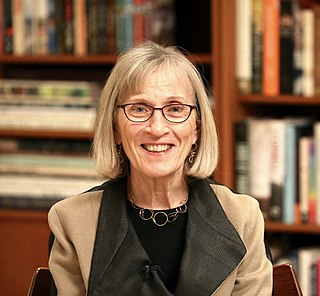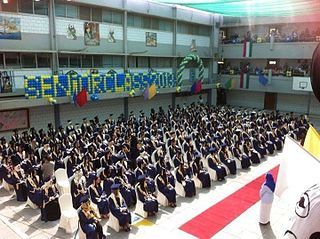In the United States, education is provided in public and private schools and by individuals through homeschooling. State governments set overall educational standards, often mandate standardized tests for K–12 public school systems and supervise, usually through a board of regents, state colleges, and universities. The bulk of the $1.3 trillion in funding comes from state and local governments, with federal funding accounting for about $260 billion in 2021 compared to around $200 billion in past years.

Secondary education is the last six or seven years of statutory formal education in the United States. It culminates with twelfth grade. Whether it begins with sixth grade or seventh grade varies by state and sometimes by school district.

Social mobility is the movement of individuals, families, households or other categories of people within or between social strata in a society. It is a change in social status relative to one's current social location within a given society. This movement occurs between layers or tiers in an open system of social stratification. Open stratification systems are those in which at least some value is given to achieved status characteristics in a society. The movement can be in a downward or upward direction. Markers for social mobility such as education and class, are used to predict, discuss and learn more about an individual or a group's mobility in society.
Achievement gaps in the United States are observed, persistent disparities in measures of educational performance among subgroups of U.S. students, especially groups defined by socioeconomic status (SES), race/ethnicity and gender. The achievement gap can be observed through a variety of measures, including standardized test scores, grade point average, dropout rates, college enrollment, and college completion rates. The gap in achievement between lower income students and higher income students exists in all nations and it has been studied extensively in the U.S. and other countries, including the U.K. Various other gaps between groups exist around the globe as well.

Single-sex education, also known as single-gender education and gender-isolated education, is the practice of conducting education with male and female students attending separate classes, perhaps in separate buildings or schools. The practice of single-sex schooling was common before the 20th century, particularly in secondary and higher education. Single-sex education is practiced in many parts of the world based on tradition and religion; recently, there has been a surge of interest and the establishment of single-sex schools due to educational research. Single-sex education is most popular in English-speaking countries (regions) such as Singapore, Malaysia, Ireland, the United Kingdom, Hong Kong, South Africa and Australia; also in Chile, Israel, South Korea and in many Muslim majority countries. In the Western world, single-sex education is primarily associated with the private sector, with the public (state) sector being overwhelmingly mixed sex; while in the Muslim world public schools and private schools are sex-segregated. Motivations for single-sex education range from religious ideas of sex segregation to beliefs that the sexes learn and behave differently. As such, they thrive in a single-sex environment. In the 19th century, in Western countries, single-sex girls' finishing schools, and women's colleges offered women a chance of education at a time when they were denied access to mainstream educational institutions. The former was especially common in Switzerland, the latter in the U.S. and the U.K., pioneers in women's education.

The educational attainment of the U.S. population refers to the highest level of education completed. The educational attainment of the U.S. population is similar to that of many other industrialized countries with the vast majority of the population having completed secondary education and a rising number of college graduates that outnumber high school dropouts. As a whole, the population of the United States is spending more years in formal educational programs. As with income, levels differ by race, age, household configuration, and geography.
The second goal in the United Nations Millennium Development Goal is to achieve Universal Primary Education, more specifically, to "ensure that by 2015, children everywhere, boys and girls alike will be required to complete a full course of primary schooling." Education is vital to meeting all other Millennium Development Goals: "Educating children gives the next generation the tools to fight poverty and prevent disease, including malaria and AIDS." Despite the significance of investing in education, the recent report, Fixing the Broken Promise of Education for All: Findings from the Global Initiative on Out-of-School Children—produced by UNESCO Institute for Statistics and UNICEF found that the world has missed this 2015 target of universal primary education, and there are currently 58 million children, of primary school age, out of school worldwide.

Claudia Goldin is an American economic historian and labor economist who is currently the Henry Lee Professor of Economics at Harvard University. She is a co-director of the NBER's Gender in the Economy Study Group and was the director of the NBER’s Development of the American Economy program from 1989 to 2017. Goldin's research covers a wide range of topics, including the female labor force, the gender gap in earnings, income inequality, technological change, education, and immigration. Most of her research interprets the present through the lens of the past and explores the origins of current issues of concern. Her recently completed book Career & Family: Women's Century-Long Journey toward Equity was released on October 5, 2021.

The history of education in the United States covers the trends in formal educational in America from the 17th century to the early 21st century.

Female education is a catch-all term for a complex set of issues and debates surrounding education for girls and women. It is frequently called girls' education or women's education. It includes areas of gender equality and access to education. The education of women and girls is important for the alleviation of poverty. Broader related topics include single-sex education and religious education for women, in which education is divided along gender lines.
The Universal Declaration of Human Rights has emphasized education's importance as a fundamental human right and a necessary element of development. Education encompasses the scope of social values, morality, tradition, religion, politics and history. It is the acquired body of knowledge that equips the emerging labor force with the necessary skills to ensure its active participation in economic development. The acquisition of literacy, arithmetic, and problem-solving skills improves the value and efficiency of labor. It creates a skilled and intellectually flexible labor force through training, expertise, and academic credentials. A professional working force enhances the quality of a nation's economic productivity and guarantees its suitability for global market competitiveness. According to a recent research report by the United Nations Population Fund, countries such as Egypt, Jordan, and Algeria have invested in family planning, healthcare, and education and have subsequently experienced more rapid economic development than the countries that were reluctant to invest in social development programs.

The State of Kuwait, located at the head of the Persian Gulf, supports an educational policy that seeks to provide an opportunity to all children, irrespective of their social class, including children with special needs. Kuwait was ranked 63rd on the Human Development Index report for 2011 by the United Nations Development Programme, placing Kuwait above the regional average.
Education economics or the economics of education is the study of economic issues relating to education, including the demand for education, the financing and provision of education, and the comparative efficiency of various educational programs and policies. From early works on the relationship between schooling and labor market outcomes for individuals, the field of the economics of education has grown rapidly to cover virtually all areas with linkages to education.
Educational inequality is the unequal distribution of academic resources, including but not limited to school funding, qualified and experienced teachers, books, and technologies, to socially excluded communities. These communities tend to be historically disadvantaged and oppressed. Individuals belonging to these marginalized groups are often denied access to schools with adequate resources. Inequality leads to major differences in the educational success or efficiency of these individuals and ultimately suppresses social and economic mobility. Inequality in education is broken down into different types: regional inequality, inequality by sex, inequality by social stratification, inequality by parental income, inequality by parent occupation, and many more.
Despite significant progress, education remains a challenge in Latin America. The region has made great progress in educational coverage; almost all children attend primary school and access to secondary education has increased considerably. Children complete on average two more years of schooling than their parents' generation. Most educational systems in the region have implemented various types of administrative and institutional reforms that have enabled reach for places and communities that had no access to education services in the early 90s.
Structural inequality has been identified as the bias that is built into the structure of organizations, institutions, governments, or social networks. Structural inequality occurs when the fabric of organizations, institutions, governments or social networks contains an embedded bias which provides advantages for some members and marginalizes or produces disadvantages for other members. This can involve property rights, status, or unequal access to health care, housing, education and other physical or financial resources or opportunities. Structural inequality is believed to be an embedded part of the culture of the United States due to the history of slavery and the subsequent suppression of equal civil rights of minority races. Structural inequality has been encouraged and maintained in the society of the United States through structured institutions such as the public school system with the goal of maintaining the existing structure of wealth, employment opportunities, and social standing of the races by keeping minority students from high academic achievement in high school and college as well as in the workforce of the country. In the attempt to equalize allocation of state funding, policymakers evaluate the elements of disparity to determine an equalization of funding throughout school districts.p.(14)
Women's education in Pakistan is a fundamental right of every female citizen, according to article thirty-seven of the Constitution of Pakistan, but gender discrepancies still exist in the educational sector. According to the 2011 Human Development Report of the United Nations Development Program, approximately twice as many males as females receive a secondary education in Pakistan, and public expenditures on education amount to only 2.7% of the GDP of the country. The unemployment rate of female graduates in Pakistan is approximately 3.8 times higher than that of their male counterparts.

Unequal access to education in the United States results in unequal outcomes for students. Disparities in academic access among students in the United States are the result of several factors including: government policies, school choice, family wealth, parenting style, implicit bias towards the race or ethnicity of the student, and the resources available to the student and their school. Educational inequality contributes to a number of broader problems in the United States, including income inequality and increasing prison populations. Educational inequalities in the United States are wide-ranging, and many potential solutions have been proposed to mitigate their impacts on students.

Immigrants make up about 13% of the US population, about 42 million out of a total population of 318.9 million citizens in 2017. First and second generation immigrant children have become the fastest-growing segment of the United States population. Compared to the native-born population, young adults aged 15–34 are significantly over-represented in new immigrants. Children and immigrants ages 35–44 are in similar proportion to native-born Americans, but older people are under-represented in new immigrants.
Higher education in the United States is an optional stage of formal learning following secondary education. Higher education, also referred to as post-secondary education, third-stage, third-level, or tertiary education occurs most commonly at one of the 4,360 Title IV degree-granting institutions in the country. These may be public universities, private universities, liberal arts colleges, community colleges, or for-profit colleges. Learning environments vary greatly depending on not only the type of institution, but also the different goals implemented by the relevant county and state.









